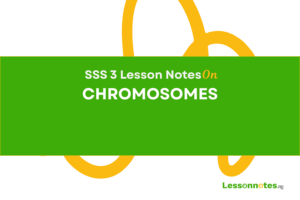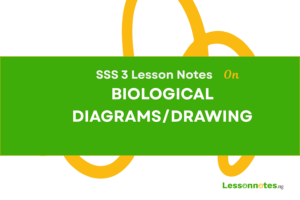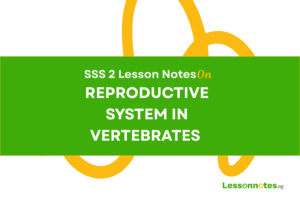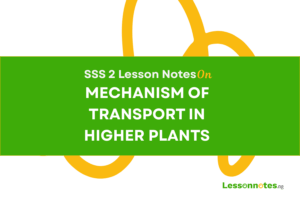Variation SS3 Biology Lesson Note
Download Lesson NoteTopic: Variation
BIOLOGY OF HEREDITARY AND VARIATION (GENETICS)
CONTENT
- Definitions of genetic terms
- Hereditary variation and causes of variation
- Transmittable/transmissible characters
- How characters get transmitted
- Mendel’s work in genetics
DEFINITIONS OF GENETIC TERMS
Genetics is the scientific study of heredity and variation in all living things. The word genetics was coined by William Bateson (1906).
Hereditary/Inheritance is the transmission and expression of characters or traits from parents to offspring. It accounts for the usual resemblance between a parent and its offspring.
Variation is the differences which exist between parents and offspring and among the offspring.
Genes are hereditary or basic units of inheritance located in chromosomes and responsible for the transmission of characters from parents to offspring. The hereditary units were named genes by Johannsen in 1909.
Chromosomes are rod or thread-like bodies found in the nucleus of a cell that houses the genes.
Characters are inheritable features possessed by an organism e.g. height, complexion, colour, etc.
Gamete is a mature sex cell that takes part in sexual reproduction. If it is of two types male and female gamete e.g pollen grains and ovules in plants, sperms and ova in man. Gamete is usually haploid.
A zygote is a single cell formed as a result of the union of male and female gametes. It is diploid.
Allelomorphs (alleles) are pairs of genes on a particular position of chromosomes. They control contrasting characters.
Locus is the site or location of a gene in the chromosome.
Genotype is the total of the genes or the genetic makeup of an individual inherited from both parents. It includes both dominant and recessive traits.
Phenotype is the total of all observable features of an organism. It includes the physical, physiological, and behavioural traits e.g. height, skin colour, etc.
A dominant trait is expressed in an offspring when two individuals with contrasting characters are crossed. A dominant trait is controlled by a dominant gene e.gTt
A recessive trait is masked, with no effect in the presence of a dominant character. This trait is controlled by a recessive gene
Homozygous is when an individual has two similar genes for the same character i.e. the individual has two identical alleles at a locus as a pair of chromosomes e.g. TT, tt.
Heterozygous is when an individual has different or contrasting alleles located on the locus as a pair of chromosomes e.g. Tt.
Filial generation is made up of offspring of parents. The generations are represented as F1, F2, F3, etc. one giving rise to the other.
A hybrid is an offspring from a cross between parents that are genetically different but of the same species.
Hybridization is the crossing of plants with contrasting characters. This can be mono hybridization (i.e. two pure traits crossed) or hybridization (two pairs of contrasting characters crossed).
Haploid is when an organism has one set of chromosomes in the gamete (23 in number). It is represented by the small letter n.
Diploid is when an organism has two sets of chromosomes in the body cell (46 in number). It is represented by 2n.
Mutation is the change in the genetic makeup of an organism resulting in a new inheritable characteristic.
EVALUATION
- Define the following terms a) Hereditary b) Variation c) alleles d) locus
- Differentiate between a) genotype and phenotype and b) Homozygous and Heterozygous being.
HEREDITARY VARIATION AND CAUSES
Hereditary variation is the differences among individuals that can be passed from the parents to their offspring (progenies).
NOTE: No two offspring inherit the same set of characteristics from parents except in identical twins. Hereditary variation arises because of
- Genetic reshuffling during meiosis due to independent assortment and segregation before the final combination results in a new individual
- Crossing over during meiosis, the chromatids get in contact with powder at the prophase stage of cell division. The homologous chromosomes break and rejoin at a point called chiasma. This results in the crossing over of genetic materials hence, variation in the offspring.
Transmittable characters in animals
These include: body stature, shape or size of the head, nose, and ear, colour of skin, hair colour, eye colour, intelligence, height, the characteristic voice of speech, blood group, baldness, tongue rolling, sickle cell anaemia, haemophilia, colour blindness, fingerprints and ability to taste phenylthiocarbamide (PTC)
Transmittable characters in plants
These include height, weight or shape of plants, their fruit, leaf, fruit taste, food content, colour of leaf or flower, fruit or seed, resistance to environmental factors like disease, pest and wind, leaf texture, life span, etc.
How characters get transmitted
Only characters controlled by genes are transmissible. Diploid organisms produce gametes by meiosis in their reproductive organs, therefore the male gamete (sperm cell) and the female gamete (ovum) are haploid organisms containing one set of chromosomes in their cell (one copy of each gene from a homologous pair.
When fertilisation takes place during sexual reproduction, the gametes (spermatozoon and ovum) fuse to form a zygote.
Each zygote is a diploid organism having two sets of chromosomes. Hence two copies of each gene (a copy donated by each gamete)
Male parent (2n) Female parent (2n)
Meiosis meiosis
Spermatozoon (n) X ovum (n)


ZYGOTE (2n)
Hence, characters determined by genes are transmitted from parents to offspring through gamete
EVALUATION
- Mention five transmittable characters each in plants and animals.
- Discuss briefly how characters get transmitted in organisms
MENDEL’S WORK IN GENETICS
In the study of genetics, Gregor Mendel (1866) worked with the garden pea
(Pisum Sativum) because of three unique properties present in it. These are
- Peas are self-pollinating
- They have a very short lifespan
- They have several unique genetic characteristics e.g. round or wrinkled seeds, tallness or shortness, seeds /pods/ flowers colouration, pod texture, etc.
The Mendel’s methods of studying genetics are two:
- Monohybrid inheritance
- Dihybrid inheritance
Monohybrid inheritance
Mendel crossed two different plants which differ in one pair of contrasting characters e.g. tall and short plants. The procedures he followed are as follows:
- He planted tall plants for several generations and got all tall plant offspring. Likewise, the short plants he planted yielded all short plant offspring.
- He then planted tall and short plants. When the flowers were produced, he cross-pollinated the pollen grains (male gamete) of the tall plant with the stigma (female gamete) of the short plant.
- He then planted the seeds of the cross in the procedure (ii) above and obtained all tall plants. This he called the first filial generation(F1,)
- He then crossed the F1 plants, collected their seeds, and sewed them. He got a tall and short plant in a ratio of 3: 1. This he called a second filial generation (F2)
Diagrammatically:
Parents’ genotypes: TT x tt
(Tall plant) (Short plant)
Gametes: T Tt t

F1 :
TtTtTtTt (All tall)
Self-pollinating: Tt x Tt
T t T t

F2 :
TT TtTttt
Genotypic ratio (GR) => 1: 2: 1
Phenotype ratio (PR) => 3: 1
This experiment resulted in Mendel’s first law of inheritance which is based on the principle of complete dominance.
Mendel’s first law of inheritance otherwise known as the law of segregation of genes states that paired alleles segregate from each other when the homologous chromosomes on which they reside separate during meiosis. Each gamete receives one of the two alleles. The actual segregation occurs in the F2 generation.
EVALUATION
- State three reasons why Gregor Mendel used Pisumsativum for his genetics experiments.
- State Mendel’s first law of inheritance.
DIHYBRID INHERITANCE
Gregor Mendel crossed plants which differ in two pairs of contrasting characteristics e.g. seed shape (round or wrinkled seeds) and seed colour (yellow or green seeds). He crossed plants having round and yellow seeds with these having wrinkled and green seeds. The F1 seeds had round and yellow seeds. Self-pollinating F1 plants produced the F2 plants of four (4) types
- Round and yellow seeds: 9
- Wrinkled and yellow seeds: 3
- Round and green seeds: 3
- Wrinkled and green seeds: 1
This experiment resulted in Mendel’s second law of inheritance
Mendel’s second law of inheritance otherwise known as the law of independent assortment of genes states that alleles of genes on different chromosomes assort independently during meiosis
Diagrammatically:
Parents’ genotypes: RYRY X ryry
(Round yellow seed) (Wrinkled green seed)
Gametes: RY RYry ry

F1: RYryRYryRYryRYry (all round yellow)
Self-pollinating:
RYry x RYry
RY rY Ry ry
Round and yellow seeds: (1), (2), (3), (4), (5), (7), (9), (10), (13): 9
Wrinkled and yellow seeds: (6), (8), (14) : 3
Round and green seeds: (11), (12), (15) : 3
Wrinkled and green seeds: (16) : 1
EVALUATION
- State the phenotypic ratios of F2 generation offspring of monohybrid inheritance and dihybrid inheritance.
- State Mendel’s second law of inheritance.
DETERMINATION OF THE GENOTYPE OF A DOMINANT PHENOTYPE
A dominant phenotype has the genotypic patterns RR, Rr. The genotype is determined using a test cross or back cross
A test cross is the crossing of organisms with a homologous recessive organism
Back cross is the crossing of an organism with a homologous recessive organism from the original parental generation
PRINCIPLE OF INCOMPLETE DOMINANCE
This deals with the ability of two contrasting alleles to interact and produce a heterozygous phenotype that is different from the two homologous phenotypes: Examples of organisms exhibiting incomplete dominance include Mirabilis Jalapa,4 o’clock plant, Audlausian fowl. This principle opposes Mendel’s principle of complete dominance.
Diagrammatically:
Parent genotypes: RR X rr
Phenotypes: (red flower) (white flower
Gametes: R Rrr

Rr Rr Rr Rr (All pink flowers)
Self-pollinating: Rr x Rr
R rRr

RR RrRr rr
Red Pink White
PR = GR = 1: 2: 1
CODOMINANCE
In codominance, both alleles in the heterozygous individuals are fully expressed. The effect of one is not modified by the presence of the other. Therefore, three distinct phenotypes are produced e.g. IAllele 1A implies the addition of antigen A to the cell surfaces of red blood cells resulting in a person with group A blood. Likewise, Allele 1B implies the addition of antigen B to the cell surfaces of red blood cells resulting in a person with Group B.
In a heterozygous individual, (1A 1B) both antigens A and B are added to the cell surfaces of red blood cells. So the individual has blood group AB.
NOTE: 1A and 1B are co-dominants while 1O is recessive.
Multiple alleles
Genes that have more than two alleles in the population are said to have multiple alleles e.g. the human ‘ABO’ blood grouping
EVALUATION
- How can the genotype of a dominant phenotype be determined?
- Use the blood group ‘ABO’ to explain co-dominance.
Sex determination in human beings
Each body cell of human beings has 23 pairs (46) of chromosomes, 22 of which are autosomes and a pair is a sex chromosome. In males the two sex chromosomes in each body cell are X and Y chromosomes, therefore, each male gamete carries either X or Y chromosome. In the female, all egg cells of the body contain two X chromosomes.
Therefore all egg cells contain one X chromosome each. At fertilisation, the combination of an egg with a sperm carrying either an X or Y chromosome occurs by chance. The formation of a male or female offspring has equal chances as shown below parents:
XY x XX

Gametes: X Y X X
XX XX XY XY 50: 50
GR = PR = 1: 1
Genotype Phenotype
(1) 2XX Girls
(2) 2XY Boys.
GENERAL EVALUATION
Define the two terms involved in the definition of genetics
- Differentiate between gamete and zygote
- Define (a) genotype (b) phenotype (c) alleles
- What is a hybrid?
- Differentiate between haploid and diploid organisms
- State Mendel’s first and second law of inheritance.
- Diagrammatically illustrate the principle of incomplete dominance.
- Using the ‘ABO’ blood group, describe the principle of codominance.
- Carry out the genetic crossing up to the F2 generation of the following :
- Group A and Group O parents.
- Group B and Group O parents.
- Group AB and group O parents.
READING ASSIGNMENT
College Biology, chapter 18, pages 409 – 428.
WEEKEND ASSIGNMENT
- The reasons why Gregor Mendel used pea PisumSativuminclude these (a) the plant is self-pollinating (b) the plant has a long life span (c) the plant has many unique properties or characteristics (d) the plant has a short life span.
- The laws of Mendel are based on the principles of (a) codominance (b) incomplete dominance (c) complete dominance (d) non-dominance
- The genotype ratio and phenotypic ratio in incomplete dominance. (a)3:1 (b) 1:2:1 (c) 1:3.(d) 2:1
- The chances of having a male or female child in humans are (a) 25% (b) 50% (c) 75% (d) 60%
- What is genetically common to 4 ‘0 clock plants and Andalusian fowl is (a) codominance (b) incomplete dominance (c) complete dominance (d) non-dominance.
THEORY
- State Gregor Mendel’s first & second law
- Use the human ‘ABO’ blood group to explain co-dominance.
- inheritance of the human “ABO” blood group





















